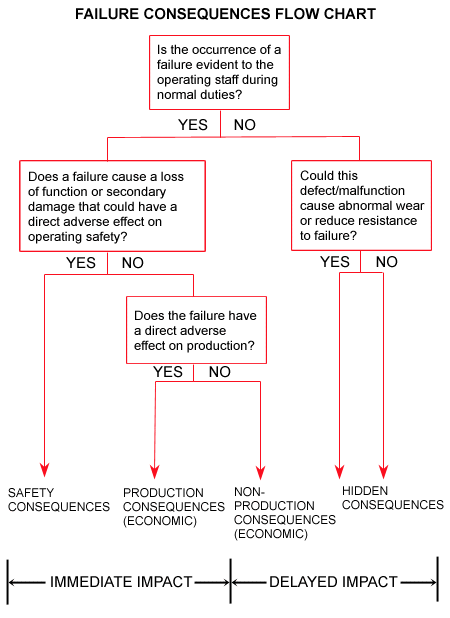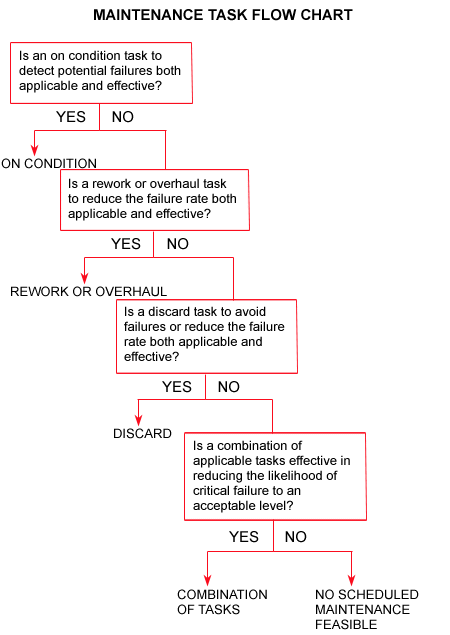
daanb@wearcheck.co.za
WearCheck Africa
WZA-006
| This bulletin follows on from WearCheck FYI 000-204 which focussed on the philosophy behind reliability-centered maintenance (RCM). In this issue we describe the practical steps towards implementing an RCM program. |
Using RCM to develop an initial maintenance program for new equipment as well as scheduled maintenance for existing plant, involves a structured decision-making process based on the consequences of functional failure of this equipment. RCM analysis produces a program which includes all scheduled tasks - and only those tasks - necessary to ensure safety and operating economy. The decision-making logic behind RCM analysis applies to any complex equipment which requires a maintenance support program aimed at maximizing operating reliability at the lowest cost.
| Objectives |
The objectives of an RCM maintenance program are:
- to realize the machinery’s inherent safety and reliability levels
- to restore the machinery’s inherent levels of safety and reliability once deterioration, malfunction or abnormal conditions have occurred
- to accomplish these objectives at a minimum cost
| RCM decision-making logic |
This involves:
- identifying significant items
- defining functional and potential failures
- assessing failure consequences
- assessing the applicability of the proposed maintenance task
- evaluating the effectiveness of the proposed maintenance task
- selecting applicable and effective maintenance tasks
- establishing initial task intervals
- exploring optimum task intervals
| Definitions |
Before examining the RCM decision-making logic, it would be useful to review some maintenance terms.
Reliability-centered
maintenance
A scheduled
maintenance program designed to realize the inherent
reliability capabilities of equipment.
Significant
item
A component
whose functional failure can have safety, production or
major economic consequences.
Applicability
The relevance
of lubrication, servicing, inspection, restoration,
discarding or monitoring an item is determined by its
characteristics.
The success of scheduled maintenance in achieving reduced failures, plant availability or cost-effectiveness.
Hidden-failure/malfunction
An abnormal
condition which is not evident to the operating or
maintenance staff during their normal duties and
inspections. This includes contamination and abnormal
wear.
Overhaul
A unit is
completely disassembled and re-manufactured part by part
to restore it to a "like new" physical
condition.
Rework
A set of
maintenance operations considered sufficient to restore
the unit’s original resistance to failure. Rework
for specific items may range from replacement of a single
part to complete remanufacture. Both overhaul and rework
are considered restoration tasks.
Discard
The scrapping
of an item when it has reached a safe-life limit (to
avoid critical failures) or an economic-life limit (to
avoid non-critical failures).
On
condition
Scheduled
inspections to detect potential failures. Units are
removed or repaired "on the condition" that
they do not meet the required standard. For an on
condition task to be effective it must be possible to
detect reduced failure resistance for a specific failure
mode; it must be possible to define a potential failure
condition which can be detected by an explicit task and
there must be a reasonable time interval between the time
of potential failure and functional failure.
Condition
monitoring
A process
characterized by the absence of preventive maintenance
tasks. An item is maintained by condition monitoring if
it is permitted to remain in service without preventive
maintenance until functional failure occurs.
Failure-finding tasks such as oil analysis and
performance monitoring may be assigned.
Cost-effectiveness
If the
failure consequences only involve operational
consequences and not safety, the cost of finding and
| Evaluating failure consequences |
The first step in developing an RCM program is to evaluate the consequences of equipment failure. This identifies significant items and determines the priorities of the maintenance effort. The different types of failure consequences include:
- safety consequences - possible fire, destruction or injury
- operational consequences - direct economic loss due to lost production plus cost of repair
- non-operational consequences - direct cost of repair only
- hidden consequences - reduced component life due to abnormal wear and contamination
Failure consequences can be evaluated using the flow chart below:
| Evaluating maintenance tasks |
The next phase of RCM analysis involves a systematic study of the different failure modes of each significant item to establish the benefits of scheduled maintenance. One needs to determine whether one of the basic maintenance tasks will satisfy both the criterion for applicability and the specific conditions for effectiveness. There is a specific order of preference to the use of preventive tasks as the Maintenance Task Flow Chart shows.
Scheduled on condition inspections directed at specific failure modes are the most desirable type of task. They are aimed at detecting reduced resistance to failure. The component remains in service until a potential failure is discovered. Where visual inspection is impractical, oil and filter analysis can detect abnormal wear and contamination.
On condition tasks include checking of pressures, temperatures, speeds, flow rates, output power, current draw, vibration, fluid levels, fluid leaks, cycle times, borescope inspections, and oil
If no applicable and effective on condition task can be found, scheduled rework or overhaul is the second choice.
If no task or combination of tasks are applicable and effective, the unit cannot benefit from scheduled maintenance. Replacement or product improvement/redesign should be considered.

| Developing an initial program |
We are now ready to develop an initial maintenance program for plant from the research that has been completed. We have already listed all the significant items that could benefit from maintenance, and a list of all known and envisaged functional failure modes for each component has been compiled.
We now consider the failure consequences of each functional failure. If a failure is found to have
The maintenance schedule should now be drawn up using conservative task intervals. Job cards are prepared detailing what tasks are to be done at a service. Task cards can be compiled to indicate how inspection and servicing are to be done and to define limits and procedures. Each task card

Lastly, optimum service and inspection intervals are developed with operating experience. Tasks must be scheduled frequently to minimize failures, with the overall aim of finding a reasonable balance between low maintenance costs and low failure rates.
| Examples |
RCM decision-making logic is applied to two common industrial components as examples of how scheduled maintenance can extend equipment life.
EXAMPLE 1: Industrial gearbox
Safety consequences? No
Operational consequences? Yes, loss of production
Economic consequences? Yes, cost of repair/replacement
Hidden consequences? Yes, contamination causing high wear
rates
Function failure mode:
bearing, gear, shaft or thrust washer failure.
Potential failure indications: abnormal wear and
overheating, seal failure.
Is an on condition task
applicable and effective? Yes
Is an overhaul task applicable and effective? No
Is a discard task effective? No
Is a combination of tasks effective? No
- Initial scheduled
maintenance program for gearbox:
Visually inspect oil level (weekly) - Visually inspect for leaks and seal damage (weekly)
- Test for overheating and high electric motor current (weekly)
- Perform oil analysis to monitor oil and machine condition (every 3 months)
Economic considerations:
In a small gearbox holding 0.5 litres of oil, the oil -
and even the gearbox - is inexpensive to replace and oil
analysis may not be cost-effective unless the failure
consequences are critical or
EXAMPLE 2: Industrial hydraulic system
Hydraulic systems and their controls can be very complex so only the basic power pack is considered here:
Safety consequences? Yes,
bursting hoses can cause injury and fire, and loss of
power can result in loss of control over the load in
cranes.
Production consequences? Yes, loss of production.
Economic consequences? Yes, cost of repair and fluid
loss.
Hidden consequences? Yes, abnormal wear and contamination
reduce component life.
Initial scheduled maintenance program
- Visually inspect fluid level (weekly)
- Visually inspect for leaks and flexible hose damage (weekly)
- Check system operating pressure (weekly)
- Check load cycle times (weekly)
- Drain off water and sediment accumulation (weekly)
- Perform fluid analysis to monitor fluid and machine condition (every 3 months)
- Perform filter analysis (every 3 months)
Economic considerations:
In large systems holding a few thousand liters of
hydraulic oil, an oil change can be extremely expensive.
The oil should not be changed while it is still fit for
service. Oil analysis can confirm oil integrity by
testing the additive package, particle count and the
level of other contaminants. Minor particulate
contamination can be removed by external on-site
filtration.
| Reference |
F.S. Nowlan, H.F. Heap - Reliability-Centered Maintenance.